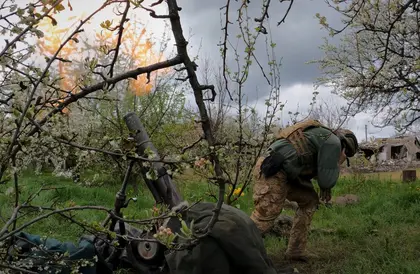Kyiv’s military leadership has yet to throw the Armed Forces’ Ukraine big punch in its ongoing summer offensive, and for the past two weeks has kept mostly to tactics of limited risk for modest ground gains.
Of the nine to twelve “reserve” combat brigades the Armed Forces of Ukraine (AFU) leadership has likely earmarked for the long-awaited offensive, only five have actually been committed to combat, and some only in part, Kyiv Post research of official Ukrainian combat reports, independent news platforms and military social media found.
- Check the most up-to-date Ukraine news reports from today.
- Access the latest Ukraine news coverage for today.
JOIN US ON TELEGRAM
Follow our coverage of the war on the @Kyivpost_official.
Thus far in the offensive the AFU’s top command has, instead of committing all its new “reserve” brigades wholesale, deployed them case-by-case in narrow attacks at selected locations. There is evidence the AFU strategy now is to bet on veteran brigades with long service on the fighting line, and often specializing in short-range infantry assaults.
The authoritative analytical platform Geoconfirmed in a Monday situation report, citing open-source media, identified a total of five AFU “reserve” brigades that were recently fielded and now are confirmed in combat at least in part: 23rd Mechanized Brigade, 31st Mechanized Brigade, 35th Marine Brigade, 37th Marine Brigade and 47th Mechanized Infantry Brigade. According to Geoconfirmed all these formations were fighting in the vicinity of the east Zaporizhzhia region. Kyiv Post research agreed with that evaluation.

Zelensky Meets CIA Director William Burns in Ukraine
For every “reserve” brigade now involved in the AFU’s three big pushes currently in progress, the AFU has committed at least one veteran brigade to fight alongside it, sometimes more, and in one sector it seems likely only older, combat-tested units are doing the fighting and gaining ground, research showed.
"The night is dark and full of terrors"
— GeoConfirmed (@GeoConfirmed) June 19, 2023
Remarks for today:
- Remember that -what seems like- a wrecked vehicle can, in many cases, be repaired if they can retrieve it. This counts for both sides. Regarding the Ukrainian Counter Offensive: "The Nine" alone have over 1500… pic.twitter.com/2b7VrxFeng
In the high-profile push in the Velyka Novosilka sector, five reserve brigades committed to combat appear to be fighting alongside three veteran formations (4th Tank, 68th Jaeger and 93rd Mechanized). One, the 93rd, first in battle against the Russian military in 2014, and repeatedly deployed to the violent Donbas “ceasefire line” from 2015-2021, arguably is one of the most combat-experienced formations not just in the AFU, but in Europe.
In the western Orikhiv sector, a single reserve brigade, the Leopard tank- and Bradley infantry fighting vehicle-equipped 47th Brigade, is flanked by two long-serving regular army brigades. One is the Uzhhorod-raised 128th Mountain Infantry, another AFU unit with a fighting record dating back to Russia’s earlier invasion of Ukraine, in 2014.
In the Bakhmut sector, Ukrainian advances have been gradual, continuous, and wholly conducted by seasoned units like the Kyiv-raised 3rd Assault and Ivano-Frankivsk’s 10th Mountain Infantry Brigades. Reserve formations, of any kind, are absent in this sector, the GeoConfirmed report said.
On paper, a full-strength Ukrainian combat brigade contains 1,000-1,500 men, 100-150 armored vehicles, and 20-40 heavy artillery pieces.
The AFU’s recently raised “reserve” brigades lack combat experience but are equipped with a mix of modern and Cold War-era heavy weapons donated by Ukraine’s Western allies. Some of their personnel have, in most cases, received one or two months of training from NATO instructors.
Actual manpower and tank and fighting vehicle counts in a veteran AFU unit are usually between 50-80 percent of paper strength and less in actual combat. The fighting effectiveness of an experienced combat brigade is nevertheless widely accounted to be better, and frequently a lot better, than a green AFU unit thrown into battle for the first time.
On the tactical level, in the present offensive, Ukrainian troops have launched a series of careful, short-range assaults on Russian positions directly opposite them, preceding the attacks with intense drone reconnaissance and punishing bombardments aimed to isolate enemy trenches and bunkers, a Monday report from Radio Liberty citing tankers and infantrymen from 35th Marine Brigade said. Armored vehicles aren’t used for breakthroughs, but to drive up to the Russian frontline positions and pound them, the report said. Frontline soldiers interviewed by Kyiv Post confirm the wide use of such tactics.
Ukraine’s latest battlefield success, the capture of the tiny village Pyatykhatky, in the Tokmak sector, formally declared liberated by the AFU on Monday morning, was carried out by dismounted infantry squads from the veteran 128th Mountain Brigade. The attack advanced Ukrainian lines a little less than a kilometer southward.
Hanna Malyar, Ukraine’s Deputy Minister of Defense and a frequent AFU spokeswoman, in Monday comments released to news platforms said that “in the past two weeks” the Ukrainian military had liberated eight settlements and advanced “up to 7 km deep into enemy territory”: an effective footman’s pace offensive advance Ukrainian lines about 500 meters a day.
The widely-predicted medium-term objectives of Ukraine’s southern offensive – the road, rail and political hubs Tokmak and Melitopol – are respectively some 30 and 70 km. from Pyatykhatky.
The last major combined arms push by the AFU southward – a 47th Mechanized Brigade armored assault on June 10 near the town Nova Tokmachka – was blunted with losses in US-made infantry fighting vehicles and German tanks, after the 47th, a reserve brigade, hit minefields and then was ambushed by Russian infantry armed with anti-tank missiles, and Russian helicopter gunships.
You can also highlight the text and press Ctrl + Enter






